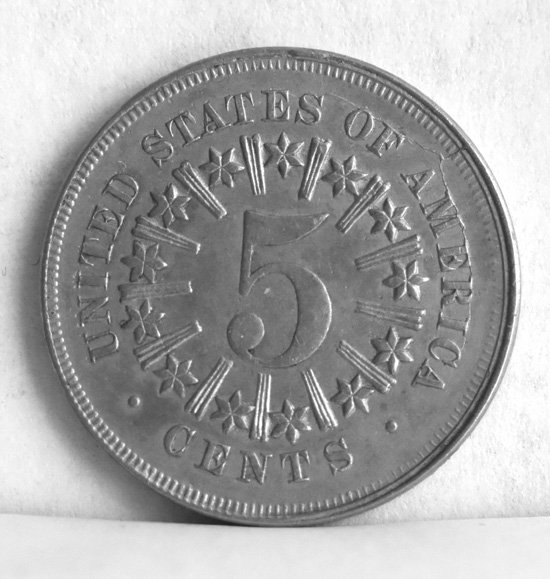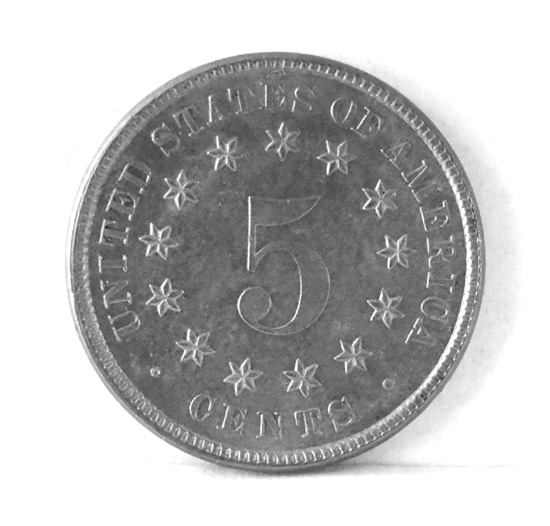Shield Nickel
1866 to 1867 Rays
1867 to 1883 No Rays
 |
In 1866 the first true Nickels appeared. Having observed that the three-cent nickel was being accepted by the people, with its composition of three-fourths copper and one-fourth nickel, the government wanted to issue a half dime with the same metals, thus to conserve on silver, which was in short supply due to the war. The coin was originally struck with a shield on the obverse and a large numeral 5 surrounded by stars and rays on the reverse. Part way through the 1867 production year, the rays were removed. |  |
| This is the obverse of the nickel and is likely an AU example worth about $220. I do have one uncirculated issue, dated 1872 and worth about $235. I am working on a complete album of these coins and currently have 15 of the 21 slots in the album. | This is the reverse of the coin at left, showing the rays between the stars. | |
 |
My album contains slots for both of the 1873 variations which are labelled open 3 and closed 3 and slots for the 1877, 1878, years during which only proofs were made. There is also a slot for the 1880 year during which both proofs and coins for circulation were minted. But since only 16,000 coins were minted for circulation, very few of these have survived today and thus they are very expensive. Surprisingly enough, while only 3,955 proofs were made, these are cheaper and I bought one, although I have not had it certified. |  |
| This is another example of the obverse which on this date was made without rays between the stars on the reverse. | This is the reverse of the coin at left. |
| 1867: January 1: The Covington–Cincinnati Suspension Bridge opens between Cincinnati, Ohio and Covington, Kentucky in the United States, becoming the longest single-span bridge in the world. January 8: African-American men are granted the right to vote in the District of Columbia. February 15: Johann Strauss II's waltz The Blue Danube is first performed, at a concert of the Vienna Men's Choral Association. March 1: Nebraska is admitted as the 37th U.S. state. March 16: An article by Joseph Lister, outlining the discovery of antiseptic surgery, is first published in The Lancet. March 30: Alaska is purchased for $7.2 million from Alexander II of Russia, which is about 2 cents per acre, by United States Secretary of State William H. Seward. Newspapers call this Seward's Folly. May 7: Alfred Nobel patents dynamite in the United Kingdom. May 29: Queen Victoria signs the British North America Act, creating the Dominion of Canada, effective July 1. June 19: A firing squad executes Emperor Maximilian of Mexico and two of his lieutenants. July: The Reverend Thomas Baker, a Wesleyan Methodist missionary is cooked and eaten by Navatusila tribespeople at Nabutautau, Fiji, together with eight of his local followers, the last missionary in that country to suffer cannibalism. September 30: The United States takes control of Midway Island. October 21: Near Medicine Lodge Creek, Kansas, a landmark treaty is signed by southern Great Plains Indian leaders, requiring Native American Plains tribes to relocate to a reservation in western Oklahoma. Date unknown: South African diamond fields are discovered. At Fountain Point, Michigan, an artesian water spring begins to gush continuously. Yellow fever kills 3,093 in New Orleans. |